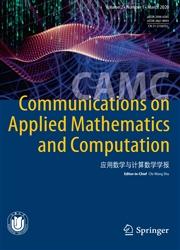指数收敛多尺度有限元方法
IF 1.4
4区 数学
Q2 MATHEMATICS, APPLIED
Communications on Applied Mathematics and Computation
Pub Date : 2022-12-01
DOI:10.48550/arXiv.2212.00823
引用次数: 1
摘要
本文简要介绍了指数收敛多尺度有限元法(ExpMsFEM)在非均质介质无尺度分离和高频波传播中的有效模型缩减。ExpMsFEM建立在经典MsFEM的无重叠区域分解的基础上,系统地丰富了逼近空间,在基函数数量上实现了接近指数的收敛速度。与文献中大多数MsFEM的推广不同,ExpMsFEM不依赖于单位函数的任何划分。一般来说,有必要使用依赖于右侧的函数表示来打破代数Kolmogorov n -width障碍以实现指数收敛。实际上,ExpMsFEM提供的函数表示中有在线部分和离线部分。在线部分局部依赖于右侧,可以有效地并行计算。离线部分包含在伽辽金法中用于装配刚度矩阵的基函数;它们都独立于右侧,因此刚度矩阵可以在多查询场景中重复使用。本文章由计算机程序翻译,如有差异,请以英文原文为准。
Exponentially Convergent Multiscale Finite Element Method
We provide a concise review of the exponentially convergent multiscale finite element method (ExpMsFEM) for efficient model reduction of PDEs in heterogeneous media without scale separation and in high-frequency wave propagation. The ExpMsFEM is built on the non-overlapped domain decomposition in the classical MsFEM while enriching the approximation space systematically to achieve a nearly exponential convergence rate regarding the number of basis functions. Unlike most generalizations of the MsFEM in the literature, the ExpMsFEM does not rely on any partition of unity functions. In general, it is necessary to use function representations dependent on the right-hand side to break the algebraic Kolmogorov n -width barrier to achieve exponential convergence. Indeed, there are online and offline parts in the function representation provided by the ExpMsFEM. The online part depends on the right-hand side locally and can be computed in parallel efficiently. The offline part contains basis functions that are used in the Galerkin method to assemble the stiffness matrix; they are all independent of the right-hand side, so the stiffness matrix can be used repeatedly in multi-query scenarios.
求助全文
通过发布文献求助,成功后即可免费获取论文全文。
去求助
来源期刊

Communications on Applied Mathematics and Computation
MATHEMATICS, APPLIED-
CiteScore
2.50
自引率
6.20%
发文量
523
 求助内容:
求助内容: 应助结果提醒方式:
应助结果提醒方式:


